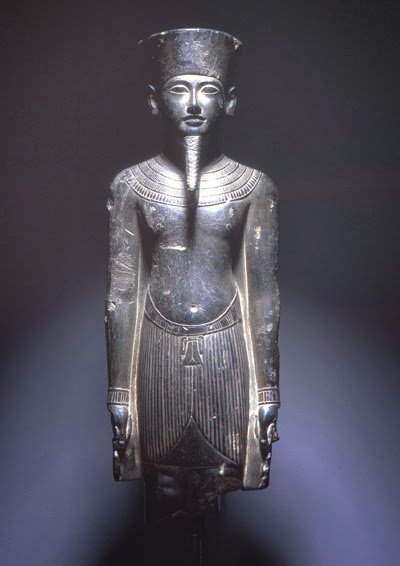Amarna: Ancient Egypt's Place in the Sun is a long-term exhibit in our Egyptian galleries, featuring more than 100 ancient artifacts. Some of these artifacts have never before been on display—including statuary of gods, goddesses and royalty, monumental reliefs, golden jewelry as well as personal items from the royal family, and artists’ materials from the royal workshops of Amarna. Most of the show’s artifacts date to the time of Tutankhamun and the Amarna Period, including many objects excavated almost a century ago.

The Amarna Period in ancient Egyptian history—circa 1353 to 1336 BCE— has long fascinated archaeologists, historians and the public—and not just because of Howard Carter’s spectacular discovery, in 1922, of the intact tomb of the Pharaoh Tutankhamun,” noted Egyptologist Dr. David Silverman, one of three curators of the Amarna exhibition and national curator of the blockbuster Tutankhamun exhibition. “It is during this period that a still somewhat mystifying, short-lived experiment in religious, artistic and cultural change was happening at Amarna, and, from that seat of the royal court, quickly extended throughout Egypt.”



Other highlights from the exhibition, housed in two gallery rooms off the Museum’s Lower Egyptian gallery, include two statues that probably represent Tutankhamun: a bronze kneeling statuette and an elegant standing figure of Amun with Tutankhamun’s features. The latter statue is an indication of Egyptian religion reverting to traditional presentations connecting the king and the god Amun at the head of the pantheon. Other statues of traditional gods in the exhibition include the lioness-headed goddess Sekhmet and the mother-son Isis and Horus.
var objHead = document.getElementsByTagName('head');var objCSS = document.createElement('link');objCSS.rel = 'stylesheet';objCSS.href = 'http://res.hoteltravel.com/style/calendar/zpcal/themes/winter.css';objCSS.type = 'text/css';objHead[0].appendChild(objCSS);var objCSS = document.createElement('link');objCSS.rel = 'stylesheet';objCSS.href = 'http://www.hoteltravel.com/partner/style/searchbox2.css';objCSS.type = 'text/css';objHead[0].appendChild(objCSS);
Philadelphia (PA) Hotel ReservationDestination
Check-in Check-out
Check-out Rooms :ChildAdult(s)
Rooms :ChildAdult(s)
 var cal = new Zapatec.Calendar.setup({firstDay: 1,weekNumbers: false,showOthers: true,electric: false,inputField: c_ARRDTHIDDENTXTID,button: c_ARRDTIMGID,ifFormat:"%d/%m/%Y",daFormat:"%d/%m/%Y",numberMonths: 1,monthsInRow: 1,dateStatusFunc: disallowDateBefore});var cal = new Zapatec.Calendar.setup ({firstDay: 1,weekNumbers: false,showOthers: true,electric: false,inputField: c_DEPTDTHIDDENTXTID,button: c_DEPTDTIMGID,ifFormat:"%d/%m/%Y",daFormat:"%d/%m/%Y",numberMonths: 1,monthsInRow: 1,dateStatusFunc: disallowDateAfter});setcurrentdate('EN');doValidation();document.getElementById('htnWidget_btnSearch').style.backgroundColor = '#EBEAEA';
var cal = new Zapatec.Calendar.setup({firstDay: 1,weekNumbers: false,showOthers: true,electric: false,inputField: c_ARRDTHIDDENTXTID,button: c_ARRDTIMGID,ifFormat:"%d/%m/%Y",daFormat:"%d/%m/%Y",numberMonths: 1,monthsInRow: 1,dateStatusFunc: disallowDateBefore});var cal = new Zapatec.Calendar.setup ({firstDay: 1,weekNumbers: false,showOthers: true,electric: false,inputField: c_DEPTDTHIDDENTXTID,button: c_DEPTDTIMGID,ifFormat:"%d/%m/%Y",daFormat:"%d/%m/%Y",numberMonths: 1,monthsInRow: 1,dateStatusFunc: disallowDateAfter});setcurrentdate('EN');doValidation();document.getElementById('htnWidget_btnSearch').style.backgroundColor = '#EBEAEA';
Personal items of ancient royalty—a seal and a scarab of Amenhotep III, vessel fragments bearing cartouches of queens Nefertiti and Tiye, a comb, an elegant statue of an Amarna princess—remind the visitor of the individuals who lived at that time. An ancient wooden mallet, fiber brush, unfinished statue and decorative molds for the making of glass items speak to the presence of a vibrant artisan community.
More than a decade before British archaeologist Howard Carter discovered Tutankhamun’s extraordinary tomb in the Valley of the Kings, American explorer Theodore Davis found a nearby pit that contained vessels from the boy king’s funerary feast, among other things.
Visit the Amarna website
Source: University of Pennsylvania Museum of Archaeology and Anthropology [September 25, 2013]